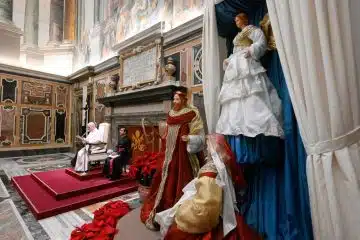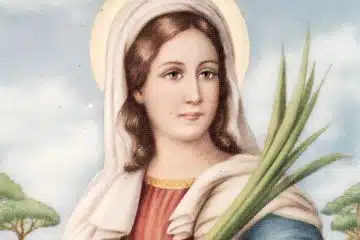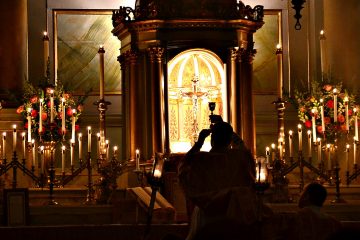May is the perfect time to plant a garden for Mary
May 6, 2009
ARCHDIOCESE — As you make your way to the garden center or nursery in the next few weeks for plants and flowers to beautify your garden this summer, consider the possibility of devoting some part your green space to plants that can have a religious significance by creating a Mary Garden.
A tradition dating back to medieval times, a Mary Garden can be as small as a single pot or as large as your yard or even a botanical garden. A statue of the Blessed Mother is usually placed somewhere in the garden and then surrounded by plants that have a Marian significance, either by their name, use or tradition.
There are hundreds of herbs and flowers that have a tie to Mary, so climate and soil variations need not be an obstacle to having a Mary Garden.
There are some wonderful resources for the beginning gardener. One particularly useful book, published by St. Anthony Messenge Press, is Mary’s Flowers: Gardens, Legends and Meditations,” by Vincenzina Krymow, a Centerville resident.
 |
In the book, Krymow describes the rich history of flowers named for Mary in medieval times when devotions to her encompassed all parts of daily life. Gardens were created in Mary’s honor and planted with flowers that extolled her different virtues or important events in her life.
For example, the marigold flower is a derivative of “Mary’s gold,” as early Christians once called it. They would plant the flower with its round yellow or orange blossoms around statues of Mary in place of coins as an offering.
Krymow also describes how the evolution of gardens devoted to Mary was influential in shaping Marian devotion.
Beginning in 12th-century Europe, cloistered, circular rose gardens became popular as places to reflect on Mary’s life. White, red and yellow roses were often used because they symbolized the joyful, sorrowful and glorious events in Mary’s life. The term “rosarium” means rose garden and evolved into the word “rosary,” the prayer that reflects on the events in Mary’s life.
Mary gardens became popular in America in the 1950s, when Ed McTague and John Stokes Jr. established a nonprofit organization called Mary’s Gardens, with a mission to revive the practice of devotion to Mary through gardening, writes Krymow. Today, homes and churches across the country have embraced this practice and made it their own.
According to Krymow, five large Mary Gardens, each with an original statue of the Madonna and all connected with religious institutions, are located east of the Mississippi River — two in the Archdiocese of Cincinnati.
• The Garden of Our Lady across from St. Joseph Church in Woods Hole on Cape Cod, Mass., grows behind a six-foot-tall yew hedge, and it’s the oldest known Mary Garden in this country. It is an enclosed garden.
• The Mary Garden at St. Mary’s Church, Annapolis, Maryland, is located behind the church in the quadrangle formed by the church, rectory and historic Carroll House on Duke of Gloucester Street in the heart of old Annapolis.
• The Mary Garden at the Shrine at Our Lady of Lourdes Grotto at Mount Saint John near Dayton includes a grotto that’s a proportional model of the Lourdes Grotto at Massabielle in France.
• Mary’s Garden at St. Catherine of Siena Church in Portage, Mich., runs along the front of the church, high on a hill
• The Mary Garden at the Episcopal Convent of the Transfiguration covers a shady hillside on the grounds of the convent in the Glendale in Cincinnati This tranquil Mary Garden grows under huge shade trees and is filled with shade-loving plants.
Information about creating a Mary garden is available online at: www.mgardens.org, which offers practical information on gardening and names, meanings and legends about the plants associated with Mary. The University of Dayton Marian Library’s Mary Page (www.udayton.edu.mary) also offers resources for learning more.
And one of the better sites for explaining the medieval names of flowers and plants and their religious meaning is http://www.fisheaters.com/marygardens.html. Here you’ll discover that many popular local flowers have potential for a Mary Garden. Begonias can represent the heart of Jesus or Mary; canterbury bells are Mary’s Bells; German legend says that carnations bloomed at the Nativity; marigolds are Mary’s Gold; clematis is Virgin’s Bower; geraniums are known as Lady Beautiful; hosta are also known as Assumption lilies; hydrangea is the Ave Maria plant; lily of the valley are Lady’s Tears; petunias are Lady’s Praise; lilac is the Ascension flower; peonies are the Pentecost roses.
Herbs can also have significance: sage is Mary’s Shawl; rosemary is Mary’s Nosegay; thyme is Virgin’s humility; valerian is Lady’s needlework, and so the list goes on.
A little careful planning can insure that Marian plants are in bloom throughout the spring, beginning with crocus and pansies in March or April, moving along with lily of the valley and lilac in May, roses in June and July, snapdragons and marigold through the late summer and early fall with trees, shrubs and late-blooming plants.
Start simple so that the garden is a pleasure, not a burden to the laborer. It can offer a wonderful site for reflection, for prayer, or for pure appreciation of God’s gifts.












